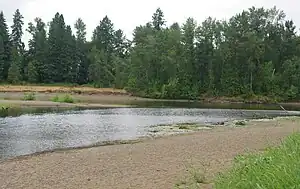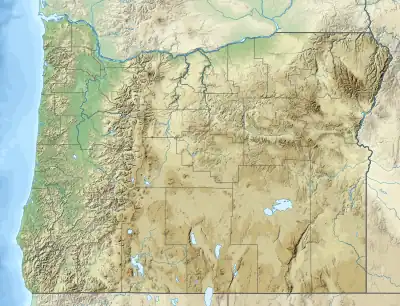Calapooia River
The Calapooia River is an 80-mile (130 km) tributary of the Willamette River in the U.S. state of Oregon.[4]
| Calapooia River | |
|---|---|
 The Calapooia River at its confluence with the Willamette River, Albany | |
 Location of the mouth of the Calapooia River in Oregon | |
| Etymology | For the Kalapuya people of the Willamette Valley[1] |
| Location | |
| Country | United States |
| State | Oregon |
| County | Linn |
| Physical characteristics | |
| Source | Cascade Range |
| • coordinates | 44°15′54″N 122°19′25″W[2] |
| • elevation | 4,552 ft (1,387 m)[3] |
| Mouth | Willamette River |
• coordinates | 44°38′20″N 123°6′36″W[2] |
• elevation | 180 ft (55 m)[2] |
| Length | 80 mi (130 km)[4] |
| Basin size | 374 sq mi (970 km2)[4] |
| Discharge | |
| • average | 898 cu ft/s (25.4 m3/s)[4] |
The Calapooia flows generally northwest from its source in the Cascade Range near Tidbits Mountain. In its upper reaches, it passes through parts of the Willamette National Forest. Further downstream, it flows through Holley then Crawfordsville and Brownsville in the Willamette Valley before joining the Willamette at Albany. The city of Tangent is also near the river on a branch of one of its downstream tributaries, Lake Creek. The confluence of the two rivers is about 120 miles (190 km) by water from where the Willamette joins the Columbia River[5]
The Calapooia was named for the Kalapuya (also spelled Calapooia), a tribe of Native Americans.[1]
Tributaries
Named tributaries of the river from source to mouth are Eighteen, Treadwell, and United States creeks followed by the North Fork Calapooia River. Then come King, Potts, Barrett/Hands, Washout, McKinley and Blue creeks. Further downstream are Biggs, Fox, Sweet Honey, Cedar, Pugh, Sawyer, Johnson, and Brush creeks. Finally come Warren, Cochrane, Courtney, Lake, and Oak creeks.[5]
Dams
The Brownsville Dam was built in the late 1800s, later rebuilt as a small concrete dam. It was removed in 2007 to allow better fish passage and address safety concerns.[6][7]
The small Sodom Dam and Shearer Dam were both removed in 2011, leaving the Calapooia River free of any human-made dams.[8][9]
References
- McArthur, Lewis A.; McArthur, Lewis L. (2003) [1928]. Oregon Geographic Names (7th ed.). Portland, Oregon: Oregon Historical Society Press. pp. 137–38. ISBN 0-87595-277-1.
- "Calapooia River". Geographic Names Information System (GNIS). United States Geological Survey. November 28, 1980. Retrieved August 8, 2010.
- Source elevation derived from Google Earth search using GNIS source coordinates.
- Palmer, Tim (2014). Field Guide to Oregon Rivers. Corvallis: Oregon State University Press. pp. 175–76. ISBN 978-0-87071-627-0.
- "United States Topographic Map". United States Geological Survey. Retrieved January 28, 2016 – via ACME Mapper. The map includes mile markers along the Calapooia and Willamette rivers.
- Desirée Tullos; Debra S Finn; Cara Walter (18 September 2014). "Geomorphic and ecological disturbance and recovery from two small dams and their removal". PLOS One. 9 (9): e108091. Bibcode:2014PLoSO...9j8091T. doi:10.1371/JOURNAL.PONE.0108091. ISSN 1932-6203. PMC 4169487. PMID 25233231. Wikidata Q30430447.
- Patrick Lair (30 November 2006). "Albany firm will oversee removal of Calapooia dam". Albany Democrat-Herald. Wikidata Q107297327.
- Alex Paul (30 July 2011). "So long, Sodom Dam". Albany Democrat-Herald. Wikidata Q107282164.
- Alex Paul (19 August 2011). "Shearer Dam demolition under way". Albany Democrat-Herald. Wikidata Q107282169.